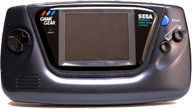Presentation
The Sega Game Gear is an 8-bit handheld game console released by Sega on October 6, 1990 in Japan, 1991 in North America and Europe, and Australia in 1992. As part of the fourth generation of gaming, the Game Gear primarily competed with Nintendo's Game Boy, the Atari Lynx and NEC's TurboExpress. The handheld shares much of its hardware with the Sega Master System and is able to play its own titles as well as those of the Master System, the latter being made possible by the use of an adapter. Containing a full-color backlit screen with a landscape format, Sega positioned the Game Gear as a technologically superior handheld to the Game Boy.
Though the Game Gear was rushed to market, its unique game library and price point gave it an edge over the Atari Lynx and TurboExpress. However, due to issues with its short battery life, lack of original titles, and weak support from Sega, the Game Gear was unable to surpass the Game Boy, selling approximately 11 million units. The Game Gear was succeeded by the Sega Nomad in 1995, discontinued in 1997 and re-released by Majesco in 2000. Several Game Gear titles were released on the Nintendo 3DS Virtual Console service on the Nintendo eShop in 2012. Retrospective reception to the Game Gear is mixed with criticisms over its battery life, praises for its full-color backlit screen, and uneven reception over the quality of its game library.
History :
Developed under the name "Project Mercury", the Game Gear was first released in Japan on October 6, 1990, in North America and Europe in 1991, and in Australia in 1992. Originally retailing at JP¥19,800 in Japan, US$149.99 in North America, and GB£99.99 in Europe, the Game Gear was designed to compete with the Game Boy, which Nintendo had released in 1989. The console had been designed as a portable version of the Master System, and featured more powerful systems than the Game Boy, including a full-color screen, in contrast to the monochromatic screen of its rival. In order to improve upon the design of their competition, Sega designed the Game Gear with a similar shape to a Genesis controller, with the idea being that the curved surfaces and longer length would make the Game Gear more comfortable to hold than the Game Boy. Despite the similarities the Game Gear shared with the Master System, the games of the latter were not directly playable on the Game Gear, and were only able to be played on the handheld by the use of an accessory called the Master System Converter. The original Game Gear pack-in title was Columns, which was similar to the Tetris cartridge that Nintendo had included when it launched the Game Boy.


With a late start into the handheld gaming market, Sega rushed to get the Game Gear into stores quickly, having lagged behind Nintendo in sales without a handheld on the market. As one method of doing so, Sega based the hardware of the Game Gear on the Master System, albeit with a much larger color palette than its predecessor: the Game Gear supported 4096 colors, compared to the 64 colors supported by the Master System. Part of the intention of this move was to make Master System games easy to port to the Game Gear. Though the Game Gear had been designed to be technologically superior to the Game Boy, the design changes came at a cost of battery life: whereas the Game Boy could run for more than 30 hours on four AA batteries, the Game Gear required six AA batteries and could only run for three to five hours. With its quick launch in Japan, the handheld sold 40,000 units in its first two days, 90,000 within a month, and the number of back orders for the system was over 600,000. According to Sega of America marketing director Robert Botch, "there is clearly a need for a quality portable system that provides features other systems have failed to deliver. This means easy-to-view, full-colour graphics and exciting quality games that appeal to all ages."
Technical Specification :
- Processor : Z80 clocked 3,58MHz
- 24 KB RAM
- Color number: 32 colors in 4096, resolution 160x146 pixels, 64 sprites from 8x8 pixels simultaneous
- Display : Color LCD, 8,3 cm
- screen backlighted;
- sound : mono, stereo 4 channel with headset.
- battery: 6 ( 2X3 ) LR6.







 alt.webp)
.webp)